|
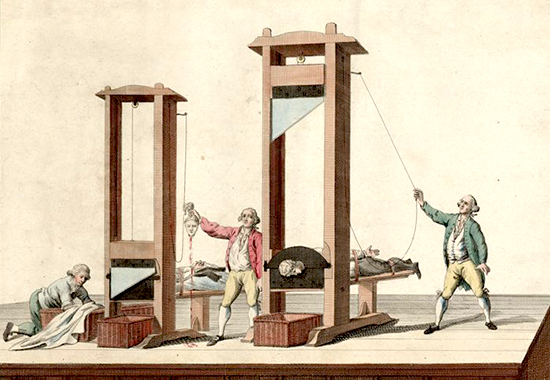
For Those Who Read Instruction Manuals: Before and After
The
Guillotine
The
 French Revolution
introduced many new concepts and designs. Some were kept,
some were forgotten.
French Revolution
introduced many new concepts and designs. Some were kept,
some were forgotten.
One of these new
ideas was the guillotine, and it was
definitely a keeper.
|
|
Image Above
Egte
afbeelding van de guillôtine te Parys
Authentic image of
the guillotine in Paris.
Print, Amsterdam
(?), 1795
Bibliothèque nationale de France, département
Estampes et photographie |
In fact, in France, the guillotine was in use from 1792
until 1981.
It was a great success and adopted by
other European states. Even Greece and Hanover had one.
Why Was the
Guillotine Invented?
The guillotine was
invented to make capital punishment a humane experience, as opposed to the
horrors of the tortures of the wheel or the
stake, the unreliable beheading by sword, or the infamy of hanging.
But there was another
revolutionary aspect to it, and that was equality of the death penalty.
Beheading, usually
by sword, was
considered a privilege and reserved for the nobles. The
average criminal was hung or worse.
With the introduction of
the guillotine came the abolition of privileges on
death row.
The Device
The guillotine was a device for
decapitation, invented to execute capital punishment as
swiftly and as neatly as possible.
The apparatus separated head
from body by a
heavy blade that fell down between two upright
posts that were joined by a crossbeam.
Similar
Instruments
Beheading had been a popular way
of execution since people could carry sticks. In time,
decapitation typically involved
swords, axes, or hatchets of sorts.
Inventing a contraption for the
purpose was the logical next step. In England, there
was the
Halifax Gibbet, for
example.
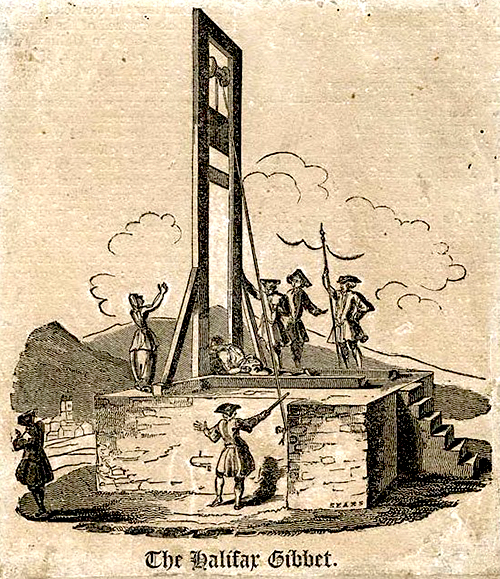
The Halifax
Gibbet, Halifax, Yorkshire
Copyright Calderdale
Council
What was the difference between
the Halifax Gibbet and the common gibbet?
Originally, the gibbet
was synonymous with gallows. Later, it referred to gallows
with dead bodies of criminals hung from it in chains after
execution.
In Scotland, it was
The Maiden that
stood proudly at Edinburgh from 1564 to
1710.
Ironically, James Douglas,
who was the 4th Earl of Morton and the man who invented
The Maiden, ended up on it in 1578. More irony to come.
Here is the Scottish Maid:
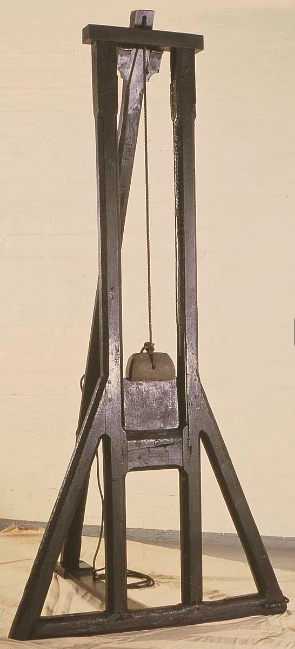
The Maiden
National Museum of
Scotland
Similar devices were developed all
across Europe, for example by the Germans (who called it diele or
hobel), the Dutch (who brought it to East India),
the Italians (who called it mannaia), the
Russians, the Poles, the Danes, etc.
It was not uncommon, however, that
it took three or four attempts to finish the job. This hacking was generally undesired and to be avoided
if possible.
The guillotine was different in
that it made a swift and clinical cut. Welcome to advanced
beheading.
Who Invented the
Guillotine?
You would think the name gives
it away, but the French doctor and politician
Joseph Ignace Guillotin did not invent
it. He only recommended to develop it.
In a nutshell, Dr. Guillotin had
nothing to do with the plan, the instructions, or
the construction of the instrument that carried his name.
The surgeon
Antoine Louis (born 1723, died in Paris in 1792)
invented the guillotine on paper. The piano maker
Tobias Schmidt (also
spelled Schmitt) built it.
|
 |
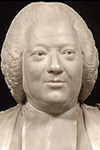 |
 |
|
The Idea |
The Plan |
The Works |
|
Dr. Guillotin |
Dr. Louis |
Mr. Schmidt |
Nicknames
First called Louisette, or
Louison (after Antoine Louis),
it was later nicknamed La Veuve (The Widow), Le Glaive de la
Liberté (The Sword of Freedom), Le Rasoir National
(The National Razor), or Sainte Guillotine.
All of these nicknames were eventually
forgotten in favor of La Guillotine.
Agreeing on
Equality
Dr. Guillotin (born at Saintes
in 1738, died at Paris in 1814) was professor of anatomy at the
University of Paris.
In 1789, Guillotin represented the
 Third
Estate as deputy of Paris to the
Third
Estate as deputy of Paris to the
 Estates General, then to the Estates General, then to the
 National Constituent Assembly.
National Constituent Assembly.
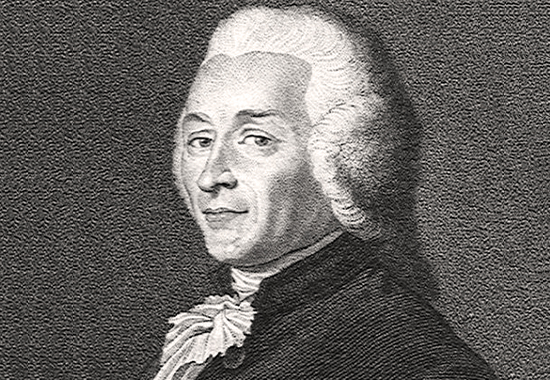
Joseph Ignace Guillotin 1738-1814
Copyright Académie nationale de
médecine
Human rights were a big concern
of the revolutionaries, at least at first, and on August 26, 1789
 The Declaration of the Rights of Man
and of the Citizen, or in French The Declaration of the Rights of Man
and of the Citizen, or in French
 Declaration des Droits de l'Homme et
du Citoyen, was adopted by the National
Constituent Assembly. Declaration des Droits de l'Homme et
du Citoyen, was adopted by the National
Constituent Assembly.
Article 8 of the Declaration
read:
"La loi ne doit établir que des peines strictement et évidemment
nécessaires."
In other
words:
"The
Law must prescribe only the punishments that are strictly and
evidently necessary."
In the October 9, 1789 session of the National Constituent
Assembly, Dr. Guillotin proposed that all death sentences
should be carried out by beheading, regardless of the
perpetrator's social state or professional rank.
Here are the minutes:
|
From the
National Assembly
Archives parlementaires
9 octobre 1789
page 393
M. Guillotin,
membre de l'Assemblée, a proposé d'ajouter
aux articles décrétés les six articles qui
suivent relatifs aux suppliciés (1) :
Art. 29. Les
mêmes délits seront punis par le même genre
de supplice, quels que soient le rang et
l'état du coupable.
Art. 30. Dans
tous les cas où la loi prononcera la peine
de mort contre un accusé, le supplice sera
le même, quelle que soit la nature du délit
dont il se sera rendu coupable. Le criminel
aura la tête tranchée.
Art. 31. Le
crime étant personnel, le supplice d'un
coupable n'imprimera aucune flétrissure à sa
famille. L'honneur de ceux qui lui
appartiennent ne sera nullement entaché, et
tous continueront d'être également
admissibles à toutes sortes de professions,
d'emplois et dignités.
Art. 32.
Quiconque osera reprocher à un citoyen le
supplice d'un de ses proches, sera puni de .
. .
Art. 33. La
confiscation des biens des condamnés ne
pourra jamais avoir lien, ni être prononcée
en aucun cas.
Art. 34. Le
corps d'un homme supplicié sera délivré à sa
famille, si elle le demande; dans tous les
cas, il sera admis à la sépulture ordinaire,
et il ne sera fait sur le registre aucune
mention du genre de mort.
|
At the session of
December 1,
1789, Guillotin gave a long speech in which he again
suggested that there should be only one kind of punishment
for capital crimes. But this time, he also proposed
to replace the executioner's arm with the action of a
machine.
"With this machine,"
he explained,
"I'll take off your head in the blink of an
eye and you don't suffer."
The Assembly had a nervous giggle
and took down his amended suggestions. Here is an excerpt:
|
Art. II. Dans
tous les cas où la loi prononcera la peine
de mort contre un accusé, le supplice sera
le même, quelle que soit la nature de délit
dont il se sera rendu coupable: le criminel
sera décapité. Il le sera par l'effet d'un
simple mécanisme.
Or in other
words:
Art. II. In
all cases in which the law pronounces the
death penalty against a defendant, the
punishment will be the same, regardless of
the nature of the offense of which he is
guilty: the criminal will be beheaded. It
will be by means of a simple mechanism.
|
Guillotin's proposals were discussed
right after his speech, and some felt that by using his machine, the
people could get accustomed to bloodshed,
whereas the use of fire or the rope would
prevent that.
But it had been a
long day, and Guillotin didn't have a prototype
or a description of his "machine" in his pocket.
So the debate got shelved for the moment.
Agreeing on
Beheading
In mid-1791, the discussion
to reform the Penal Code was in full
swing. So far, the
Assembly only decreed equality of punishment.
On June 3, 1791, the
decapitation for the death penalty was demanded by
Félix Le
Pelletier, which was basically a repetition of Guillotin's
proposition. This time, the Assembly adopted it.
On September 25, 1791, the new
Penal Code
was adopted.
|
The Penal Code
The Penal Code, or in French Code
Pénal, was a set of rules
governing violations and criminal responsibility. Its first
version was adopted in France on September 25, 1791.
::
Background
In the second half of the 18th
century appeared a current against the justice of the Ancien Régime,
which implemented cruel, unorganized, and
arbitrary punishments. In addition, the perpetrators received different
penalties depending on their status.
In 1764, the Italian
Cesare Beccaria
wrote on Des délits et des peines, or On Crimes and
Punishments.
Beccaria said that a sentence must be
"proportionate to the offense and determined by the law,"
and it should not be unnecessary or cruel. He rejected torture and the death penalty.
His work was translated into
French in 1765, and French philosophers were delighted.
 |
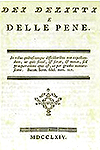 |
Cesare
Beccaria
1738-1794 |
Dei delitti
e delle pene
Crimes and Punishment |
::
The New Penal Code
In September 1789, the
Constituent Assembly created a Comité pour la réforme de la
jurisprudence criminelle, or Committee for the reform of
criminal jurisprudence, which developed a Penal Code,
supplementing the law of January 21, 1790, on offenses and
crimes.
The Penal Code was adopted by
the deputies on September 25, 1791. Now,
same crimes
were punishable by same penalties regardless
of rank or status.
regardless of the nature
of the offense, the death penalty will only be given in one
form: by decapitation and without torture.
the crime is personal,
the offender's family will not be given infamy.
heresy, magic, and
suicide, for which one did a trial in memory of the
deceased, all these "imaginary crimes" are done with.
The Penal Code was in effect until
Napoleon made some amendments in 1810. (He gave the judge
the option to rule between a minimum and a maximum sentence, for
example.)
|
The National Constituent
Assembly was the French Government until September 30, 1791. On October 1,
1791, the
 Legislative Assembly, became its successor.
Legislative Assembly, became its successor.
Agreeing on the
Guillotine
The method of decapitation was
not yet adopted and the death row had to wait until the
administration got their paper work together.
At the
end of 1791, the
Legislative Assembly charged a committee with the task of
studying and building a machine that cut heads.
The committee,
in turn, approached Doctor Antoine Louis of the
Academy de Chirurgie, asking for
his recommendation on the method of beheading.
On March 7, 1792, Louis' advice was
forwarded to the committee.
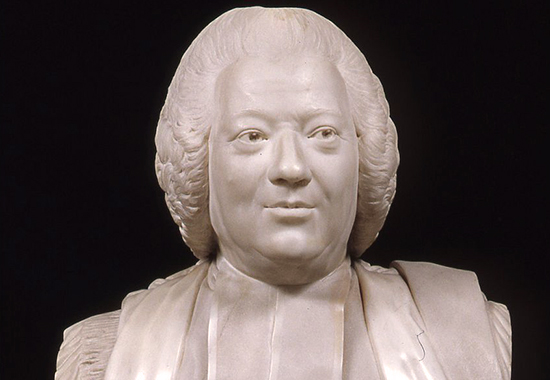
Bust of
Antoine Louis 1723-1792
Copyright Académie nationale de
médecine
On March 20, 1792, the Legislative
Assembly rendered a decree. The new instrument was adopted.
On March 25, 1792, it was sanctioned by
the King.

So far so good.
But the machine had yet to be
built and perhaps perfected.
At the time had settled at Paris a German,
a man from Strasbourg, now France. His name was
Tobias
Schmidt. A piano maker by trade, Schmidt agreed
to be the carpenter
Louis needed. Based on Louis' instructions, Schmidt crafted the
guillotine and received 824 livres for the
job.
Dress Rehearsal
The first guillotine was
taken to the Bicêtre hospital and three corpses were
decapitated. Apparently, some live sheep had been
previously practiced upon as well.
The experiments turned out
satisfactory.
The First Cut
The new instrument worked for
the first time on April 25, 1792.
It was erected on the Place de Grève
in Paris
for the execution of a robber, Nicolas Jacques Pelletier,
who had attacked a person on October 14, 1791, with several
hits of the stick which resulted in the victim's death.
The first political
guillotinade took place after the
fall of the monarchy on August 10, 1792.
See
 First Terror.
First Terror.
The Dramatic Guillotine
Contrary to
 earlier concern that
people could get accustomed to too much bloodshed, it was felt that the
quickness of the execution and the lack of visibility took
away from the demonstrative character of restorative
punishment reserved for the enemies of the revolution.
earlier concern that
people could get accustomed to too much bloodshed, it was felt that the
quickness of the execution and the lack of visibility took
away from the demonstrative character of restorative
punishment reserved for the enemies of the revolution.
Thus, the revolutionaries
decided to make a show of it, a theatrical ritual with a
permanent exhibition of the scaffold, slow arrival of the
cart with the prisoners (usually a two-wheeled cart called
the tumbrel),
display of the severed head etc.
Besides the one that was
installed in the market places, portable guillotines
were available that could be brought into the chambers of sentenced
sick offenders.
With the serial
executions of the
 Great Terror in June 1794, the
guillotine
earned its dire reputation by producing endless streams of
blood, cheered by hysterical spectators.
Great Terror in June 1794, the
guillotine
earned its dire reputation by producing endless streams of
blood, cheered by hysterical spectators.
After the
 Revolution of 9 Thermidor
on July 27, 1794, which ended the Reign of Terror, the
guillotine became a symbol of the barbaric terror of the Republic.
Revolution of 9 Thermidor
on July 27, 1794, which ended the Reign of Terror, the
guillotine became a symbol of the barbaric terror of the Republic.
The
Unpretentious Guillotine
Subsequently, the instrument was
gradually withdrawn from the public eye, away from the
center of the capital.
In 1832, it was
placed at the city gates.
In 1851, before the entrance of
the prison.
In 1872, the scaffold on which it was perched
was abolished.
From 1939, it was only used
indoors of
detention places.
The End of a
Performance
The guillotine was used in France well
into the 20th century. But only eight executions took place between 1965
and, the last one, in 1977.
France
outlawed capital punishment and abandoned the use of the guillotine on October 9,
1981. Here is the law:

Abolition of the Death Penalty in
France, 1981 - PDF
9 Octobre 1981 : Abolition de la peine de mort
Famous People on
the Guillotine — Chronologically
French
 King Louis XVI was
guillotined on January 21, 1793.
King Louis XVI was
guillotined on January 21, 1793.
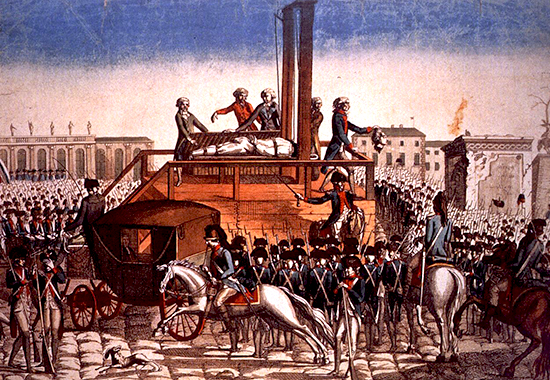
Execution of King Louis XVI
at Paris, 1793
Print by unknown artist
Bibliothèque nationale
de France
 Adam Philippe de Custine
(French general) was guillotined on August 27, 1793.
Adam Philippe de Custine
(French general) was guillotined on August 27, 1793.
French
 Queen Marie Antoinette
was guillotined on October 16, 1793.
Queen Marie Antoinette
was guillotined on October 16, 1793.
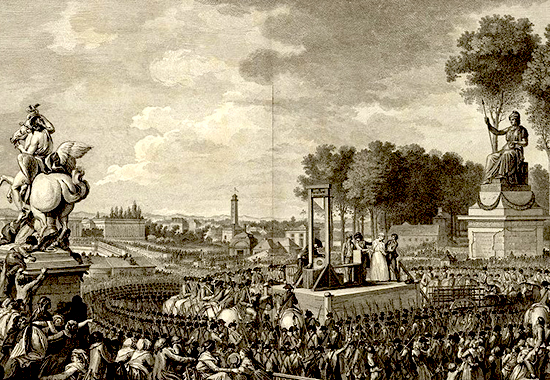
Execution of
Queen Marie-Antoinette at Paris, 1793
Engraving by Isidore-Stanislas Helman
©
Bibliothèque municipale de Versailles
Jacques
Pierre Brissot
(leader of the
 Girondins) was guillotined on October 31,
1793.
Girondins) was guillotined on October 31,
1793.
Jean Nicolas
Houchard
(French general) was guillotined on November 17, 1793.
Armand Louis
de Gontaut, duc de Biron
(French general) was guillotined on December 31, 1793.
Jacques
René Hébert (main man of the
 sansculottes,
supporter of the
sansculottes,
supporter of the
 Reign of Terror) was
guillotined on March 24, 1794. Reign of Terror) was
guillotined on March 24, 1794.
 Georges Danton
(First President of the
Georges Danton
(First President of the
 Committee of Public Safety) was guillotined on April 5, 1794.
Committee of Public Safety) was guillotined on April 5, 1794.
Camille
Desmoulins (supported the
 storming of the
bastille, the abolition of the monarchy, but dared to
criticize the Committee of Public Safety) was guillotined on
April 5, 1794.
storming of the
bastille, the abolition of the monarchy, but dared to
criticize the Committee of Public Safety) was guillotined on
April 5, 1794.
Antoine Laurent Lavoisier
(French chemist and tax farmer) was guillotined on May 8,
1794.
Princess
Elizabeth of France (Louis XVI's baby sister) was
guillotined on May 10, 1794.
 Maximilien de Robespierre (major contributor of
guillotine candidates) was guillotined on July 28, 1794.
Maximilien de Robespierre (major contributor of
guillotine candidates) was guillotined on July 28, 1794.
Antoine Quentin
Fouquier-Tinville (public prosecuter of the
Revolutioanry Tribunal who put Marie-Antoinette, Brissot,
Desmoulins, and Hébert on the guillotine) was guillotined on
May 7, 1795.
 François Noël Babeuf (communist
revolutionary) was guillotined on
May 27, 1797.
François Noël Babeuf (communist
revolutionary) was guillotined on
May 27, 1797.
Voilà, the
history of the guillotine.

More History
|